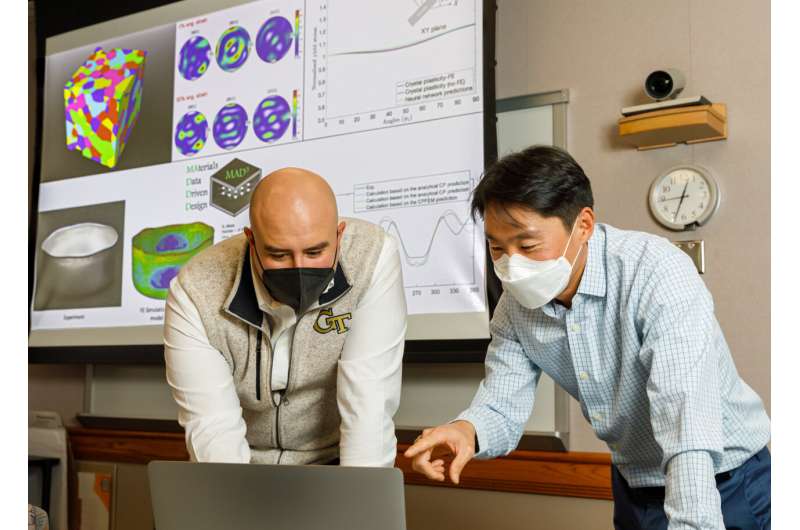

Machine learning used to predict direction-dependent mechanical properties of me...
source link: https://techxplore.com/news/2022-02-machine-direction-dependent-mechanical-properties-metals.html
Go to the source link to view the article. You can view the picture content, updated content and better typesetting reading experience. If the link is broken, please click the button below to view the snapshot at that time.

February 15, 2022
Machine learning used to predict direction-dependent mechanical properties of metals
by Sandia National Laboratories
 Sandia National Laboratories researchers David Montes de Oca Zapiain, left, and Hojun Lim examine data generated by the machine learning algorithm Material Data Driven Design. Credit: Bret Latter
Sandia National Laboratories researchers David Montes de Oca Zapiain, left, and Hojun Lim examine data generated by the machine learning algorithm Material Data Driven Design. Credit: Bret Latter
A machine-learning algorithm developed at Sandia National Laboratories could provide auto manufacturing, aerospace and other industries a faster and more cost-efficient way to test bulk materials.
The technique was published recently in the scientific journal Materials Science and Engineering: A.
Production stoppages are costly. So, manufacturers screen materials like sheet metal for formability before using them to make sure the material will not crack when it is stamped, stretched and strained as it's formed into different parts. Companies often use commercial simulation software calibrated to the results of various mechanical tests, said Sandia scientist David Montes de Oca Zapiain, the lead author on the paper. However, these tests can take months to complete.
And while certain high-fidelity computer simulations can assess formability in only a few weeks, companies need access to a supercomputer and specialized expertise to run them, Montes de Oca Zapiain said.
Sandia has shown machine learning can dramatically cut time and resources to calibrate commercial software because the algorithm does not need information from mechanical tests, said Montes de Oca Zapiain. Nor does the method need a supercomputer. Additionally, it opens a new path to perform faster research and development.
"You could efficiently use this algorithm to potentially find lighter materials with minimal resources without sacrificing safety or accuracy," Montes de Oca Zapiain said.
Algorithm replaces mechanical tests
The machine-learning algorithm named MAD3, pronounced "mad cubed" and short for Material Data Driven Design, works because metal alloys are made of microscopic, so-called "crystallographic" grains. Collectively, these grains form a texture that makes the metal stronger in some directions than others, a phenomenon that researchers call mechanical anisotropy.
"We've trained the model to understand the relationship between crystallographic texture and anisotropic mechanical response," Montes de Oca Zapiain said. "You need an electron microscope to get the texture of a metal, but then you can drop that information into the algorithm, and it predicts the data you need for the simulation software without performing any mechanical tests."
Teaming with Ohio State University, Sandia trained the algorithm on the results of 54,000 simulated materials tests using a technique called a feed-forward neural network. The Sandia team then presented the algorithm with 20,000 new microstructures to test its accuracy, comparing the algorithm's calculations with data gathered from experiments and supercomputer-based simulations.
"The developed algorithm is about 1,000 times faster compared to high-fidelity simulations. We are actively working on improving the model by incorporating advanced features to capture the evolution of the anisotropy since that is necessary to accurately predict the fracture limits of the material," said Sandia scientist Hojun Lim, who also contributed to the research.
As a national security laboratory, Sandia is conducting further research to explore whether the algorithm can shorten quality assurance processes for the U.S. nuclear stockpile, where materials must meet rigorous standards before being accepted for production use. The National Nuclear Security Administration funded the machine-learning research through the Advanced Simulation and Computing program.
To enable other institutions to take advantage of the technology, Sandia formed a cross-disciplinary team to develop the user-friendly, graphics-based Material Data Driven Design software. It was developed with input from more than 75 interviews with potential users through the Department of Energy's Energy I-Corps program.
Individuals and organizations interested in licensing can contact [email protected] for more information.
Recommend
-
 35
35
Predict NBA games, make money — machine learning project Past performance doesn’t indicate future performance… unless…we can get 136% returns….? :wink:
-
 10
10
In this blog, I will be covering how you can create a Rest API endpoint using Flask in Linux which consumes a Machine Learning model to predict data. Prerequisites You need to have training data and test data ready with you.
-
 11
11
Digest of the free virtual event at https://mybuild.microsoft.com/home held May 25-27, 2021 plus a bit more. Previous year digest can be found at
-
 13
13
-
 8
8
Using Machine Learning to Predict Hard Drive Failures October 12, 2021 by Andy Klein //
-
 10
10
Train a Machine Learning Model to Predict the Programming Language in a Code Snippet We are going to build a we...
-
 9
9
March 10, 2022
-
 6
6
How Can Machine Learning Predict the Stock Market?May 24th 2022 new story4
-
 8
8
Mechanical properties of aged bamboo fiber-reinforced composites under quasi-static loading by Liu Jia,...
-
 6
6
Learning the language of molecules to predict their properties This AI system only nee...
About Joyk
Aggregate valuable and interesting links.
Joyk means Joy of geeK